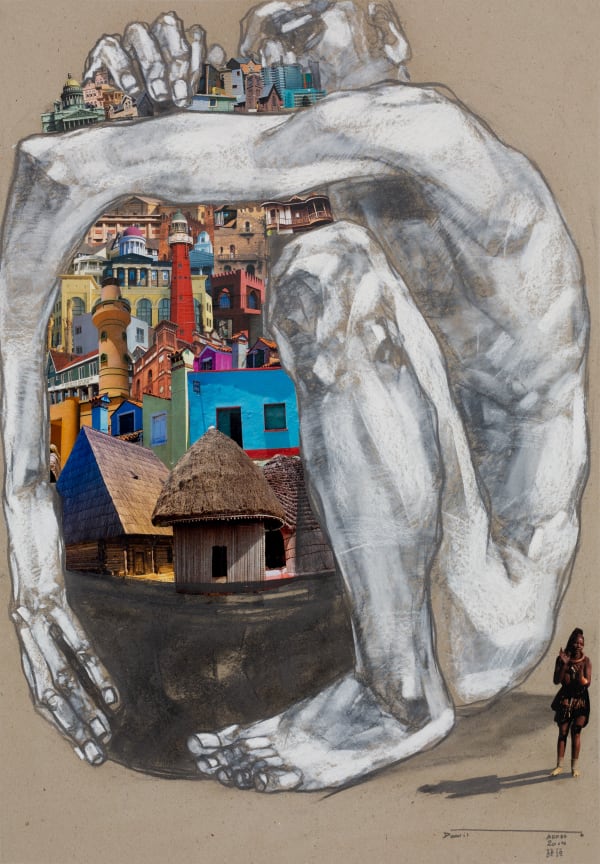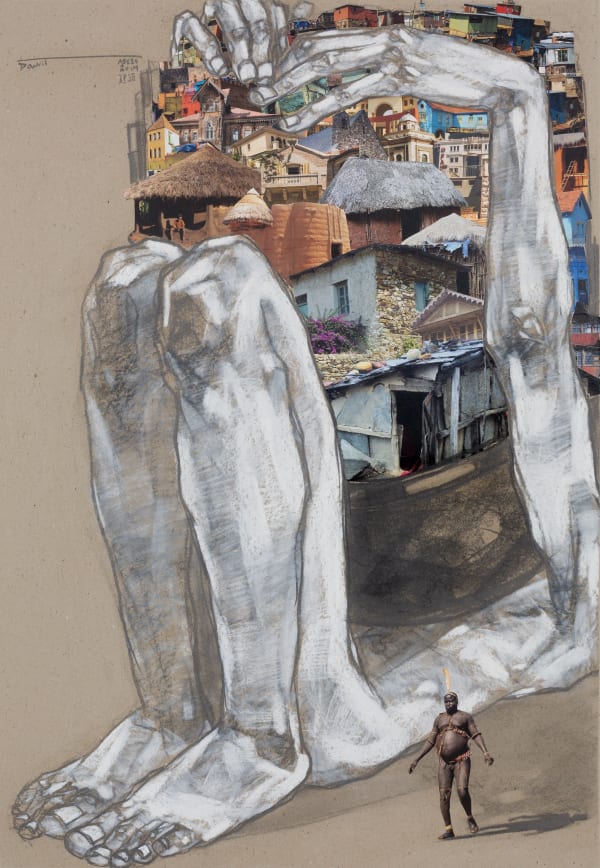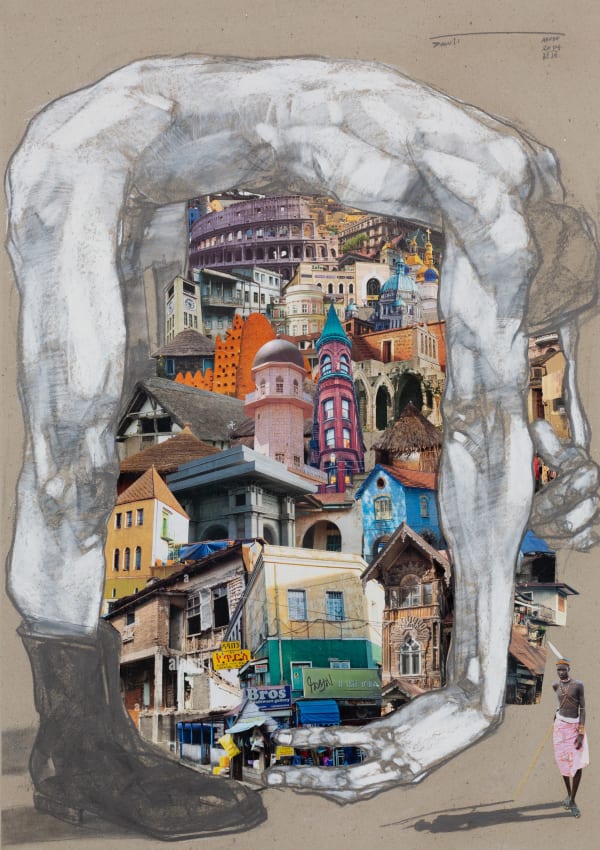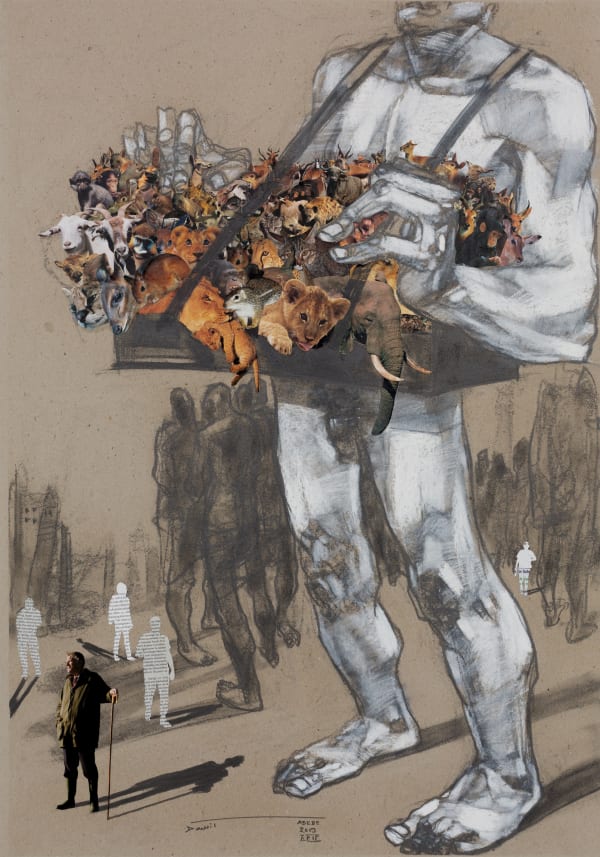-
Dawit Abebe
መጠን The Balance of Things -

-
-
Solo exhibitions include (Upcoming), “መጠን" The Balance of Things, Kristin Hjellegjerde Gallery, London (2022); Long Hands, Kristin Hjellegjerde Gallery Berlin (2021), EDIT, Kristin Hjellegjerde Gallery, London (2020); Mutual Identity, Addis Fine Art Gallery, Addis Ababa (2018); Liminal in the age of Mobile-ty, 68 Projects, Berlin (2018); “Quo Vadis?”, Kristin Hjellegjerde Gallery, London (2017); Background 2, Kristin Hjellegjerde Gallery, London (2015); Background 1, Lela Gallery, Addis Ababa (2014) and X Privacy, Alliance Ethio-Française, Addis Ababa (2012).
Group exhibitions include 1-54 London, Kristin Hjellegjerde Gallery (2021); Facing the Sun, Kristin Hjellegjerde Gallery, Schloss Görne, Germany (2021); 1-54 Contemporary African Art Fair, New York (2021); Devil´s in the detail, Kristin Hjellegjerde Gallery, London (2020); Karachi Biennial (2019); 1-54 Contemporary African Art Fair, London (2019); Kubatana, Vestfossen Kunstlaboratorium, Norway (2019); 1-54 Contemporary African Art Fair, London (2018); Imago Mundi, Trieste, at Salone degli Incanti, Italy (2018); VOLTA13, Markthalle, Basel (2017); Everything Exists Now, Kristin Hjellegjerde Gallery, London (2017); Art Dubai, with Kristin Hjellegjerde Gallery, Dubai (2017). Other major group show include What about Africa?, Witteveen Visual Art Centre, Amsterdam (2016); Pangaea II: New Art from Africa and Latin America, Saatchi Gallery, London (2015); Concerning The Internal at Circle Art Gallery, Nairobi (2015); Visibles/Invisibles, Fondation Blachere, Apt (2015); the display of the Habesha Art Collection at the National Museum in Addis Ababa (2014), and the touring exhibition Silver Sea Cross-Ship (2013-14).
-
Highlights and Collections
In 2021 Dawit Abebe was included in publication African Artists: From 1882 to Now, a book about Modern and Contemporary African artists, published by Phaidon. In 2019 Abebe was picked by Artnet as one of the two most important artists working out of Ethiopia today. In 2021 Abebe received the First Place Award from the Ethiopian Ministry of Culture and in 2017 he was named “Chevalier of France Order of Arts and Letters”. Dawit Abebe has exhibited widely internationally and some of his major exhitions include Kubatana, Vestfossen Kunstlaboratorium, Norway (2019); Karachi Biennial (2019); Imago Mundi, Trieste, at Salone degli Incanti, Italy (2018) and Pangaea II: New Art from Africa and Latin America, Saatchi Gallery, London (2015). Abebe’s work is held in international private and public collections, including the Chazen Museum of Art, Wisconsin (USA), Barjeel Art Foundation (UAE), the Rema Hort Mann Foundation (US), the Saatchi Collection (UK), the Frank Cohen Collection (UK), the Carole Server and Oliver Frankel Collection (US), The Beth Rudin DeWoody Collection (US), Ilham Collection (Malaysia), the Blanchard / Nesbitt Collection (UK) and the Easton Capital Collection (US).
-
-

-
-
Over the years, Abebe has developed a distinct artistic language that incorporates painting, drawing and collage techniques to create highly dynamic compositions that resonate not only with Ethiopian history and social fabrics, but also reflect on issues inherent to capitalism and the world order at large. The artist cites his first trip to the Omo Valley in southern Ethiopia in 2008 as a key turning point. ‘Until that moment,’ he says, ‘I was an urban citizen who did not engage with the diverse modes of life existing outside Addis in the remote regions.’ Since that first trip, he has returned several times and continues to take inspiration from the rich and diverse culture of his country. The departing point for this latest series, for example, was Abebe’s observation of a ritual amongst the Bodi tribe known as ‘Kel’. Each year, the tribe selects a group of young men to spend six months living in isolation, feeding on fresh cow’s milk and blood provided by their families with the intention of getting as fat as possible. On the day of the parade, the man who is the most overweight wins and earns the “Fattest Man” title for life, after which the participants return to the community and resume their daily lives. ‘I am fascinated by the time-based performative character of the ritual through which a capitalistic method is experimented with and then consciously dropped once it has served its purpose,’ explains the artist.
In Abebe’s compositions, the presence of an enormous, naked bulging body - rendered in vivid detail in pencil and white charcoal - comes to represent excessive human actions be it in a form of consuming food, managing nature or dealing with power and wealth. In The Balance of Things 3, for example, a figure - monstrous in both height and width - stands with his back to the viewer, wearing a sack strapped to his front filled with cut-out images of wild animals. The figure’s face is buried in the colourful collage of imagery while the shadow extending from his feet takes the form of a slender, well-dressed businessman, wearing a suit and hat. ‘It baffles me to see that even peace is dictated by the rich minority. It has become a luxury item that they can dispense or easily take away from the weak and poor if they do not abide by their rules,’ states the artist.
-
Interestingly, in these latest works, many of the smaller figures that surround the dominating figure have been literally stripped off their individual identity, their bodies turned into anonymous silhouettes cut-out from newspapers. Meanwhile, the incorporation of text relates back to the artist’s continued preoccupation with the dissemination and manipulation of knowledge. In many of the smaller scale works, the male figure is bent over or wrapped around the collaged imagery, sometimes appearing childlike in an explicit gesture of hoarding while in others, the body takes on an abstract, architectural shape. In the Balance of Things 22, for example, the figure’s torso and elongated limbs form a literal wall around the stack of buildings, creating a tactile representation of the restrictive force of dominating powers.
Abebe concludes: ‘Everything on this earth comes with its own cycles and equilibrium be it the sun, the moon, day and night, the different seasons, plants, creatures and human beings. However, the competition and greed amongst the few who amass far more than they can chew, constantly disrupts the balance of things causing irreversible damage including to the ecosystem of our planet.’
-
-
Enquire
-
 Dawit Abebe, Balance of Things 1, 2021
Dawit Abebe, Balance of Things 1, 2021 -
 Dawit Abebe, Balance of Things 10, 2021
Dawit Abebe, Balance of Things 10, 2021 -
 Dawit Abebe, Balance of Things 11, 2021
Dawit Abebe, Balance of Things 11, 2021 -
 Dawit Abebe, Balance of Things 12, 2021
Dawit Abebe, Balance of Things 12, 2021
-
 Dawit Abebe, Balance of Things 13, 2021
Dawit Abebe, Balance of Things 13, 2021 -
 Dawit Abebe, Balance of Things 14, 2021
Dawit Abebe, Balance of Things 14, 2021 -
 Dawit Abebe, Balance of Things 17, 2021
Dawit Abebe, Balance of Things 17, 2021 -
 Dawit Abebe, Balance of Things 18, 2021
Dawit Abebe, Balance of Things 18, 2021
-
-
Dawit Abebe: መጠን The Balance of Things
Past viewing_room



















